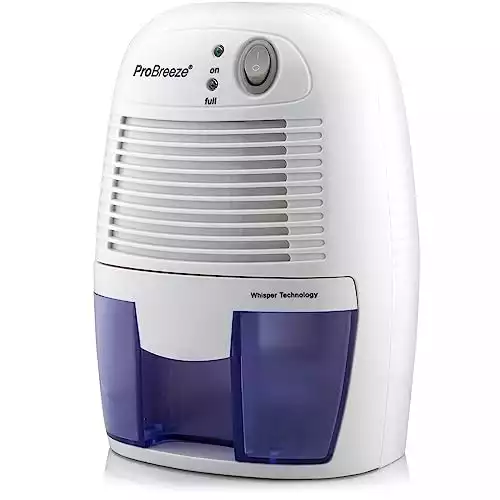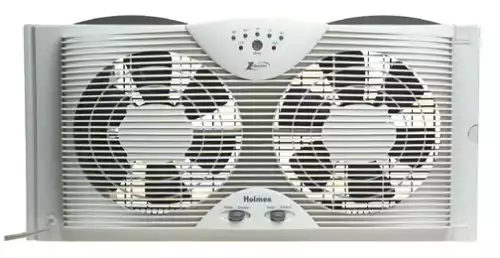HVAC Training Shop is reader-supported. As an Amazon Associate, I earn from qualifying purchases.
Are you looking for a way to keep moisture out of your wet, clammy bathroom?
Using a dehumidifier or exhaust fan will help with that.
Both of these devices will help remove stagnant, moist air from your restroom– helping prevent damage from mold, grime, and water.
But which one should you use?
There are stark contrasts between dehumidifiers and exhaust fans, with each being better at one thing versus another.
In this article, I’ll go over the differences between bathroom dehumidifiers and bathroom exhaust fans. I’ll also discuss how they each work, and provide a run-down of the pros and cons of each.
Bathroom dehumidifier or exhaust fan: Which one to choose?
As moisture removal tools, both dehumidifiers and exhaust fans offer plenty of usefulness.
But depending on the source and quantity of moisture in your bathroom, you may want to choose one over the other.
Use a dehumidifier if you have persistent humidity issues in your bathroom
If your bathroom is always humid, even when you’re not taking a shower, then you should use a dehumidifier.
Using a dehumidifier in your bathroom won’t have any adverse effects on other areas of your home. So you’ll be able to sleep easy at night knowing that you won’t be sacrificing the health of one room in your home for the other.
Ultra-quiet operation and compact size make this dehumidifier perfect for bathrooms.
Use an exhaust fan if your bathroom is only humid for short periods of time
If your bathroom is only humid when you take a shower, then an exhaust fan is the best solution.
While using an exhaust fan in your bathroom will cause outside air to seep into other areas of your home, it won’t be a problem since you will only be using it for short periods of time.
This ultra-silent exhaust fan is capable of moving 110 CFM. All the steam from your bathroom will be gone within minutes.
Bathroom dehumidifiers: Best for persistent humidity issues
Bathroom dehumidifiers work by sucking the moisture right out of the air. From there, the moisture condenses into liquid water and is stored in a collection tank.
So, what are the pros and cons of a bathroom dehumidifier? Let’s explore further.
Bathroom dehumidifier pros
Bathroom dehumidifiers provide powerful humidity reduction
Bathroom dehumidifiers work extremely well at removing humidity. They work so well, they can even make your bathroom dryer than it was before you took a shower.
If your bathroom is always humid (even when you’re not showering), then a dehumidifier will help with that.
I recommend someone with persistent bathroom humidity issues use a dehumidifier over an exhaust fan.
But why?
Even though a dehumidifier will use more energy while running, an exhaust fan will impact the energy use in your home in other ways (I’ll discuss that a bit more later).
Bathroom dehumidifiers offer precise humidity control
Most bathroom dehumidifiers include some sort of humidity sensor and control, such as a humidistat.
This means that you just set the humidistat to a certain level. The dehumidifier will automatically kick on whenever your bathroom’s air gets too wet.
What does that mean? SET IT AND FORGET IT!
You won’t need to worry about the moisture level getting too high in your bathroom since your dehumidifier will turn on before it ever reaches that point.
Bathroom dehumidifiers are inexpensive and easy to set up
Despite dehumidifiers being, on average, more expensive to purchase, they are super easy to set up and require minimal installation.
Since you won’t need to cut out your ceiling and run electrical wires, they are actually cheaper to set up and install than a ceiling exhaust fan.
The setup process for a bathroom dehumidifier is super simple, you basically just take it out of the box, plug it in, and turn it on. Within minutes your bathroom will have drier air.
Bathroom dehumidifier cons
A dehumidifier will take up valuable bathroom space
A dehumidifier is yet another device that takes up space in your already-cramped bathroom.
If you are short on square footage in your restroom, then you might want to reconsider if a dehumidifier is the best solution.
You’ll need to empty a tank or drain condensate
Since dehumidifiers suck the moisture right out of the air, they need to put that water somewhere. Most dehumidifiers have a tank that collects moisture. This tank needs to be emptied when it gets full. So you’ll have to deal with that on a regular basis.
The good news is that some dehumidifiers have the option of setting up a permanent draining solution. This is done by attaching a hose to the dehumidifier and allowing it to drain out into a sink or other pipe.
The advantage of using a permanent drain hose is that you’ll never have to worry about emptying a tank again, saving you time and the stress of having to think about it.
Bathroom exhaust fans: Best for quick humidity rejection
Bathroom exhaust fans work by blowing the moist air from your bathroom to the outside.
It’s a simple, yet effective method of moisture removal.
How does a bathroom exhaust fan compare to a dehumidifier? Read further for the pros and cons of a bathroom exhaust fan.
Bathroom exhaust fan pros
A bathroom exhaust fan gets the job done quickly
If you just need to remove the steam from your bathroom while you take a shower, then an exhaust fan will do just that.
Better yet, it will get the job done quickly and efficiently. An exhaust fan will remove the moist air from your bathroom much faster than a dehumidifier will.
This means that you won’t need to run the exhaust fan after you leave the bathroom, saving you energy costs.
Exhuast fans don’t take up space in your bathroom
Since a bathroom exhaust fan is installed in the ceiling or window, you won’t need to worry about it taking up valuable space.
This means that you’ll have more room to spread out, or put other things in your bathroom, such as a heater.
Window exhaust fans are inexpensive
Window exhaust fans are cheap and easy to install, especially if you have a sliding window.
You simply slide your window up, place the fan in the gap, and then slide the window down to secure it in place. Most window fans have flaps that allow you to fully cover the gaps on the sides of the fan.
This window exhaust fan slides right under your bathroom window. Once it’s installed, you’ll be able to exhaust your humid bathroom air quickly through the window.
Bathroom exhaust fan cons
Exhaust fans bring in unconditioned outside air into your home
How does an exhaust fan in your bathroom bring in outside air into your home? It’s all about pressure and airflow.
When you turn on the exhaust fan in your bathroom, it blows air from your home to the outside.
Bathroom exhaust fans create negative pressure inside your home.
Since your home is now negatively pressurized, air from the outside starts seeping in through the cracks and seams around the doors and windows of your home.
Think of it this way– what goes out, must come in! By exhausting air from your home, air has to come back in from the outside.
Why is that bad?
Well, now you have unconditioned air infiltrating the space in your home. This will make your HVAC system work harder to maintain the temperature and humidity levels in your home. Your AC or Furnace will need to work harder, using more energy, and costing you more money.
Ceiling exhaust fan installation is complicated and expensive
While it’s true that your average bathroom-sized dehumidifier costs more than your average bathroom exhaust fan, that’s not telling the whole story.
Most people don’t consider that an exhaust fan will require some level of installation to get it set up correctly. Especially if it’s installed in the ceiling.
Installing a bathroom exhaust fan in the ceiling will require some cutting, screwing, mounting, wiring, and patching to get everything done right. If that work doesn’t sound like it’s up your alley, be prepared to shell out a lot of extra money to get a professional to do it.
When you factor in all the installation costs of a ceiling exhaust fan, it can easily be 4-5x the cost (if not more) compared to a small dehumidifier.
Window exhaust fans aren’t very great
If you opt to go the cheap route and get a simple window exhaust fan, the downside is that they take over your window. You won’t really be able to use your window anymore.
Worse yet, window exhaust fans can potentially let bugs or other critters through their cracks. You might be surprised one night to find a spider inside your bathroom!
Is a dehumidifier or exhaust fan best for your bathroom?
In conclusion, choosing a dehumidifier or exhaust fan for your bathroom depends on a few things:
- Is your bathroom always humid, or only after you shower?
- What is the source of the humidity?
- How much space do you have in your bathroom?
However, the primary deciding factor is whether your bathroom is persistently humid, or only humid after you shower.
For persistent humidity issues, a dehumidifier makes the most sense.
For short bursts of humidity due to showering, then an exhaust fan will be a better solution.







Thank you for this interesting post. I’m a little confused reading “For short bursts of humidity due to showering, then an exhaust fan will be a better solution.” However, if exhaust fans could be 4-5x the cost of a dehumidifier, it doesn’t seem to be worth it cost-benefit wise. Our bathroom is only humid after a shower, approx. 3-4x/week. )We shower elsewhere the other days.) Any clarifying thoughts?
Hi Lesli,
You should check out some window exhaust fans. They are very cost-effective and you can install them yourself.
Hope this helps,
-Trey
Hey Trey,
I have a very large, historic home that did not have ceiling fans in the bathroom of course. It has a large window. That’s good but in winter in pennsyvlania, opening a window in the winter to get the air out isn’t necessarily ideal either.
For a few reasons (cost of installation and requirements to exhaust the fan outside through the double brick wall) I am considering just using a dehumidifier in the bathroom. A very small single room model.
BUT…
There are 4 floors of the home, each ~2500-3000 sqft and because there is no ducting system (house is 100 years old), we will go with 50 pint/4500 sqft models for each floor draining automagically.
Given that I will have these larger, full floor dehumidifiers, do I need the single room dehumidifiers for the high humidity of the bathrooms where hot, steam rich showers are taking place? The walls are slate, drywall and concrete.
I’m I worrying too much? WIth a window and a full floor dehumidifier on each floor, should I worry about no exhaust fan in the bathrooms?
Thanks!
Hi Anastasia,
The first thing you should do is check the humidity level inside your bathroom after showers. Keep the bathroom door open after showers and see if the dehumidifiers can take care of the humidity without having to resort to a separate dehumidifier for the bathroom.
-Trey